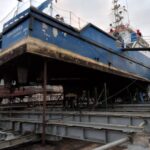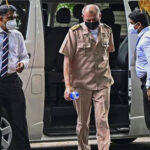Imagine a heart the size of a Suzuki four-door, with arteries wide enough for children to crawl through. Now imagine how big a creature has to be in order to possess such large organs and you’ve got yourself one of the most magnificent creatures to ever swim in the vast oceans – the massive Blue Whale.
Known as the largest creature on Earth, the Blue Whale is nearly thirty meters long and weighs up to at least 200 tonnes. Despite being twice as heavy as the largest known dinosaur, Blue Whales are quite rare to find, as they swim in the deep blue, as far away from human traffic as possible. That is unless you’re in Sri Lanka.
Our small island was well known for being one of the world’s premier locales for seeing blues and for studying them. So how did this first begin?
Commercial Whale Watching in Sri Lanka
Ayesh Ranawake – the former DGM Operations at the Ceylon Fishery Harbour Corporation (CFHC) pioneered the first official whale watching tour in Sri Lanka back in 2008.
“Most of my early life was spent at sea when I was a part of the Sri Lanka Navy. During my many expeditions, seeing these magnificent creatures in their own habitats was nothing new for me. When I embraced the life of a civilian and became a part of the CFHC, I realised that most of the experiences that I took for granted would be akin to miracles to many others. That is how my idea for Whale Watching came across,” Ranawake reminisced.
Back in 2006, Whale Watching was not something that was touched upon in Sri Lanka. That was when Ranawake spoke to the then Chairperson Professor Asanga Abeyagoonasekera in order to venture into the commercial whale watching sector.
“I built a separate unit known as the CFHC Leisure and Entertainment and created ten different job opportunities. Then, I presented my proposal along with the named job opportunities to the “Thaarunyata Hetak”, met with Attorney-at-law Mr Lalith Piyum Perera the former National Aquaculture Resources (R&D) Agency (NARA) Director-General.”
The boat required for the first-ever Commercial Whale Watching venture was provided by the National Institute of Fisheries and Nautical Engineering (NIFNE) now known as the Ocean University.
“They had a boat that they got from Japan that was not being used, which they allowed us to use and that is how the first trip began,” said Ranawake adding “We invited the media for the first trip and started the journey from Galle, passed Mirissa and went quite a distance to see the whales. It was a beautiful sight and we were able to see a magnificent number of whales, way more than the usual amount. We shared all these photographs from the trip with the then president Mahinda Rajapaksa and other officials.”
A Great Source of Regret

“While I am genuinely happy that the people of Mirissa flourished from an initiative that I personally had an involvement in, my joy is overshadowed by my worry over the welfare of the whales,” Ranawake said.
The concern that Ranawake shares with many ocean experts are the fact that this particular industry is detrimental to whales.
The whale watching industry pre-Corona was estimated to be worth over 2 billion dollars according to the International Fund for Animal Welfare (IFAW). While this is in fact booming business for humans, the whales in question are being adversely affected mainly due to badly managed whale-watching ventures.
“Whale watching – especially when so many unsanctioned boats go out sometimes over ten boats a day – it can impact on the natural behaviour of the whales, including their ability to feed, rest and even rear their young,” Ranwake said, adding “I tried my best to regulate whale watching when we began. However, my efforts were futile.”
According to Ranawake, some of the boats used for whale watching back in the day caused very loud underwater sound propagation, which was largely disruptive towards the whales, and was also causing noise pollution in the ocean.
“This noise largely pushed the whales who frequented areas where whale watching was particularly intense, straight towards the Traffic Separation Lane, causing them to be killed in traffic accidents.”
The Way Forward
Ever since the COVID-19 pandemic hit on a global scale, tourism all but vanished in the country. The Whales who were severely affected by the industry began to slowly recover. As the country too begins to recover from the pandemic, tourism will once again begin to flourish. Once the industry restarts, it is important to be mindful of the whales themselves, working towards protecting them and preserving their natural habitats, instead of driving them away from their own homes.
Whales are still in great danger, as evidenced by the recent incident where over 100 whales were stranded on a beach off the coast of Panadura. Three pilot whales and one dolphin died of their injuries following the mass beaching, while the rest of the whales were saved by the Sri Lanka Navy, with the assistance of environmental protection officers, police and local residents.
While the official cause of this massive beaching is largely unknown, theories blame noise pollution in the ocean to have disoriented the whales into beaching themselves.





